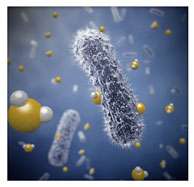Study reveals new insights into sulfate-reducing bacteria

(Phys.org) —Sulfate-reducing bacteria are common in oxygen-deprived habitats, and they can have harmful industrial and health effects as well as beneficial environmental effects. This study examines the biochemical pathways used by these microbes to convert sulfate to hydrogen sulfide.
By revealing components involved in electron transport required for sulfate reduction, this study provides novel insights into the metabolic pathways essential for the growth of sulfate-reducing bacteria. The results could potentially be used to increase the effectiveness of environmental remediation efforts and to control health and industrial problems caused by these bacteria.
Sulfate-reducing bacteria breathe sulfate rather than oxygen, reducing sulfate to hydrogen sulfide to meet their energy needs. Hydrogen sulfide is a toxic gas that smells like rotten eggs and can not only cause health problems by making its way into drinking water supplies, but also lead to metal corrosion of household plumbing as well as oil and gas pipelines. On the other hand, these bacteria can be used for environmental remediation efforts because they convert contaminants such as uranium, chromium and technetium from soluble to insoluble forms, reducing the risk of groundwater contamination with these metals. To predict and control the metabolic capabilities of these bacteria for beneficial environmental purposes, it's necessary to have a detailed understanding of the biochemical pathways involved in sulfate reduction.
To address this issue, scientists from the University of Missouri and Oak Ridge National Laboratory and examined electron transport required for sulfate reduction in bacteria. They tested the notion that sulfate reduction relies on pathways of electron flow from the periplasm—the outer portion of the cell—to the cytoplasm—the interior of the cell where sulfate reduction occurs.
To test their hypothesis, they used mutant forms of a sulfate-reducing bacterium called Desulfovibrio alaskensis. The qrcA mutant lacks a subunit of a transmembrane protein complex called QrcABCD, and the cycA mutant is deficient in a protein called type I tetraheme cytochrome c3 (TpIc3). QrcABCD spans the inner membrane separating the periplasm from the cytoplasm and thus could serve as a conduit for electron flow between these two cellular regions. On the other hand, TpIC3 is located in the periplasm and has been proposed to be an electron reservoir capable of providing electrons to transmembrane complexes such as QrcABCD.
The researchers characterized bacterial growth and examined gene expression using proteomic and transcriptomic analyses. They performed the proteomic data acquisition and analysis at EMSL, a DOE national scientific user facility, using an accurate mass and time tag approach that was developed at Pacific Northwest National Laboratory. They found that both qrcA and cycA mutations impaired bacterial growth and interrupted electron flow required for sulfate reduction.
The results suggest that both TpIc3 and QrcABCD are essential for the transfer of electrons from the periplasm to the cytoplasm to drive sulfate reduction. In addition, the work supports a recently discovered energy process that increases the efficiency of energy use in microbes. As such, the process of electrons sharing power for driving metabolism is likely to be important in schemes for biofuel production.
More information: Keller, K.L., Rapp-Giles, B.J., Semkiw, E.S., Porat, I., Brown, S.D., Wall, J.D. "New Model for Electron Flow for Sulfate Reduction in Desulfovibrio alaskensis G20." Appl Environ Microbiol 80(3):855-68. (2014). [DOI: 10.1128/AEM.02963-13].
Provided by Environmental Molecular Sciences Laboratory



















